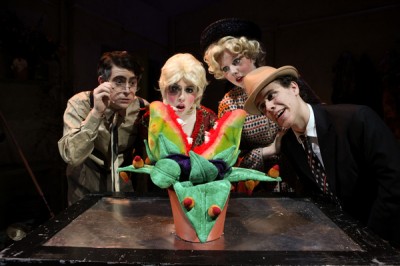Lucas Hammerman ’10
News Editor

Even after the storm devoured most of the week and trees before opening night, there was one giant talking singing plant still standing with an amazing performance around it.
The mainstage production of “Little Shop of Horrors” holds up the sterling reputation and tradition of Players productions by storming the stage with emotionally intense songs and amazing special effects.
Players feed the audience humor, music and deep conflict in their production of “Little Shop of Horrors.”
Even with little time to put the finishing touches on due to weather, the quality of performance in “Little Shop of Horrors” was still worthy of the brightest spotlight.
“Little Shop of Horrors” is a dark musical comedy that takes place in New York City in the Bowery District on Skid Row, an area best described as the slums.
On Skid Row is Mushnick Florists, owned by the animated and humorous Mr. Mushnick (Dan Shure ’10).
Inside is Seymour (Chris Nicoletti ’10/Peter Molesworth ’11) a nerdy apprentice to Mr. Mushnick with a hobby of breeding exotic plants.
Seymour is an orphan who has lived a life of poverty and was adopted by Mr. Mushnick. Seymour’s hobby of exotic plants brings him to encounter “Audrey II.”
The plant is from outer space and is a mix between an avocado plant and a Venus Fly Trap. The plant is actually four different puppets and each increases in size as the play progresses.
The largest version of the plant is 80 inches long, 50 inches wide and 40 inches tall.
The third and fourth versions of the plant are operated from the inside.
The third version is operated by Adam Bansger ’10, and the fourth version is operated by August Laska ’13.
The voice of the plant is done offstage by Robert Mathis ’10. The three executed their roles professionally and collaboratively to bring out a truly evil bloodthirsty plant, symbolizing the darker side of human nature. Seymour names the plant after Audrey (Michelle Pauker ’13/ Eva Hendricks ’11) as a secret expression of his love for her.
Throughout the play, the “strange, unusual and exotic” plant revitalizes Mushnick Florists and gives Seymour the opportunity to get out of Skid Row. The only problem is that the plant only grows when fed human
blood.
As the voice of the carnivorous plant, Mathis captures the essence of a monster: he is deep, smooth-talking and easy to trust but even easier to be betrayed by.
Mathis manipulates his voice to hit notes in time with the movement of the plant operators Bangser and Laska, perfectly transforming from puppet to character. This transformation gobbles the audience up with quirky bits and gags. All in all, Audrey II is very funny.
The last scene of the Act One ends with Seymour feeding Audrey II the limbs of Orin Scrivello D.D.S.
With the use of slow strobe lights and mist create a very eerie mood as the spotlight travels across the stage, it lands on Seymour holding the bloodied dental shirt of Orin Scrivello D.D.S. The audience is absolutely silent, not from theatre etiquette, but from the increased gravity stemming from fluent shift from comedic to dark mood that Players has pulled off by blending of superb acting, lighting and set design.
As the mood shifts, the mask of a parody is lifted to reveal the deeper play on human nature.
The song “Suddenly Seymour” set off emotional fireworks. The chemistry between the characters of Seymour and Audrey becomes very real as Nicoletti and Pauker, were focusing entirely on one another. Pauker absolutely stuns the audience with her voice.
The love duet turns comical as the ensemble emerges in golden robes. This pattern of serious to comedic kept the audience’s interest.
However, a talking carnivourous plant is pretty helpful in doing that, also.
The finale of “Little Shop of Horrors” is “Don’t Feed the Plant,” when the audience sees that Audrey II may exist within their own lives, that when we yield to greed, it only spawns more greed.
Greed is the plant. Don’t feed it because it then feeds on your soul is the message delivered in the Players’ phenomenal production of “Little Shop of Horrors.”
(All actors reviewed in this article are from the March 20 performance. This was purely a matter of scheduling not a matter of favoritism.)














































